engine coolant MITSUBISHI SHOGUN 2003 Owner's Manual (in English)
[x] Cancel search | Manufacturer: MITSUBISHI, Model Year: 2003, Model line: SHOGUN, Model: MITSUBISHI SHOGUN 2003Pages: 392, PDF Size: 14.34 MB
Page 97 of 392

D06A047A
Water temperature gauge
ED06A-Nb
The water temperature gauge indicates the
engine coolant temperature when the igni-
tion switch is“ON”.
CAUTION
If the indication needle enters the
zone “A” while the engine is run-
ning, it indicates that the engine is
possibly overheating. Immediately
park your vehicle in a safe place and
make the necessary corrections.
(Refer to “Engine overheating” on
page 8-21.)
While driving, care should always be
taken to maintain the normal operat-
ing temperature.
Instruments and controls
4-5
Div:
Out put date:
Page 170 of 392
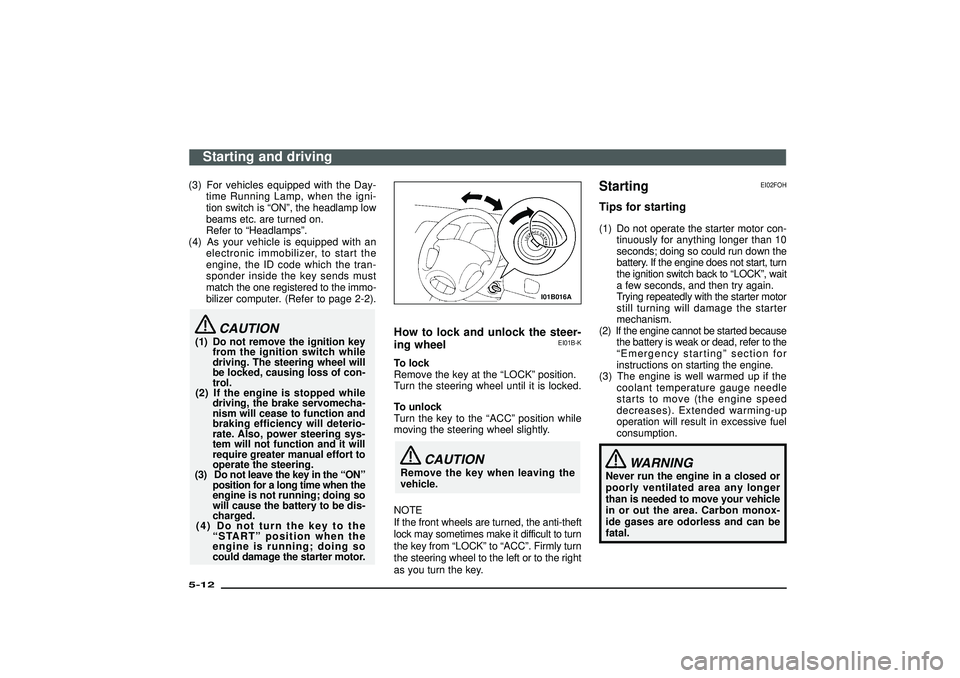
(3) For vehicles equipped with the Day-
time Running Lamp, when the igni-
tion switch is“ON”, the headlamp low
beams etc. are turned on.
Refer to“Headlamps”.
(4) As your vehicle is equipped with an
electronic immobilizer, to start the
engine, the ID code which the tran-
sponder inside the key sends must
match the one registered to the immo-
bilizer computer. (Refer to page 2-2).
CAUTION
(1) Do not remove the ignition key
from the ignition switch while
driving. The steering wheel will
be locked, causing loss of con-
trol.
(2) If the engine is stopped while
driving, the brake servomecha-
nism will cease to function and
braking efficiency will deterio-
rate. Also, power steering sys-
tem will not function and it will
require greater manual effort to
operate the steering.
(3) Do not leave the key in the“ON”
position for a long time when the
engine is not running; doing so
will cause the battery to be dis-
charged.
(4) Do not turn the key to the
“START”position when the
engine is running; doing so
could damage the starter motor.
I01B016A
How to lock and unlock the steer-
ing wheel
EI01B-K
To lock
Remove the key at the“LOCK”position.
Turn the steering wheel until it is locked.
To unlock
Turn the key to the“ACC”position while
moving the steering wheel slightly.
CAUTION
Remove the key when leaving the
vehicle.
NOTE
If the front wheels are turned, the anti-theft
lock may sometimes make it difficult to turn
the key from“LOCK”to“ACC”. Firmly turn
the steering wheel to the left or to the right
as you turn the key.
Starting
EI02FOH
Tips for starting(1) Do not operate the starter motor con-
tinuously for anything longer than 10
seconds; doing so could run down the
battery. If the engine does not start, turn
the ignition switch back to“LOCK”, wait
a few seconds, and then try again.
Trying repeatedly with the starter motor
still turning will damage the starter
mechanism.
(2) If the engine cannot be started because
the battery is weak or dead, refer to the
“Emergency starting”section for
instructions on starting the engine.
(3) The engine is well warmed up if the
coolant temperature gauge needle
starts to move (the engine speed
decreases). Extended warming-up
operation will result in excessive fuel
consumption.
WARNING
Never run the engine in a closed or
poorly ventilated area any longer
than is needed to move your vehicle
in or out the area. Carbon monox-
ide gases are odorless and can be
fatal.
Starting and driving
5-12Div:
Out put date:
Page 256 of 392
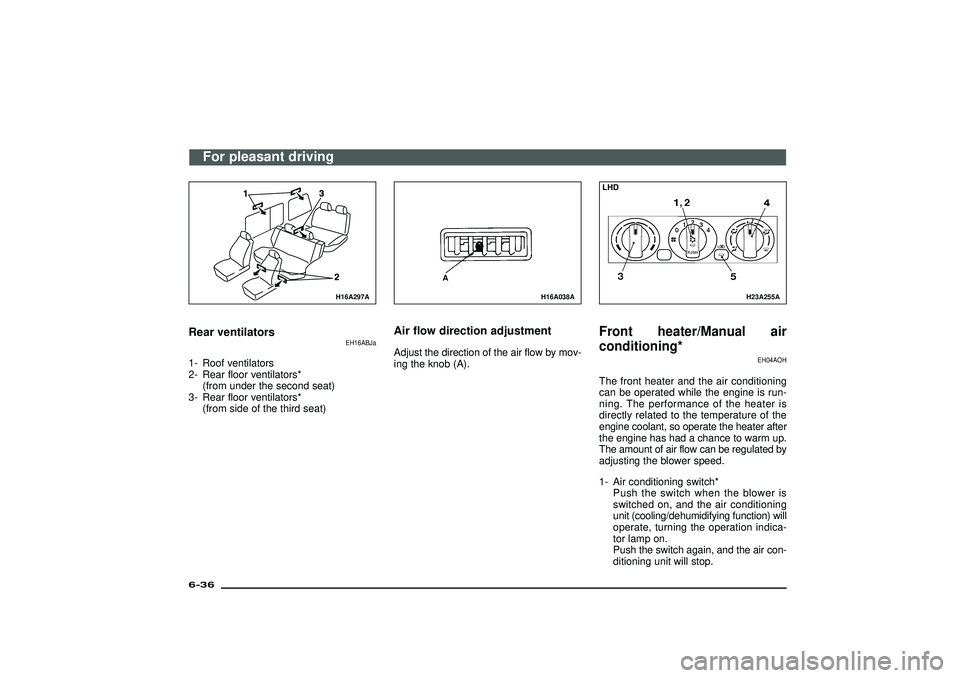
H16A297A
Rear ventilators
EH16ABJa
1- Roof ventilators
2- Rear floor ventilators*
(from under the second seat)
3- Rear floor ventilators*
(from side of the third seat)
H16A038A
A
Air flow direction adjustmentAdjust the direction of the air flow by mov-
ing the knob (A).
H23A255A
LHDFront heater/Manual air
conditioning*
EH04AOH
The front heater and the air conditioning
can be operated while the engine is run-
ning. The performance of the heater is
directly related to the temperature of the
engine coolant, so operate the heater after
the engine has had a chance to warm up.
The amount of air flow can be regulated by
adjusting the blower speed.
1- Air conditioning switch*
Push the switch when the blower is
switched on, and the air conditioning
unit (cooling/dehumidifying function) will
operate, turning the operation indica-
tor lamp on.
Push the switch again, and the air con-
ditioning unit will stop.
For pleasant driving
6-36Div:
Out put date:
Page 257 of 392
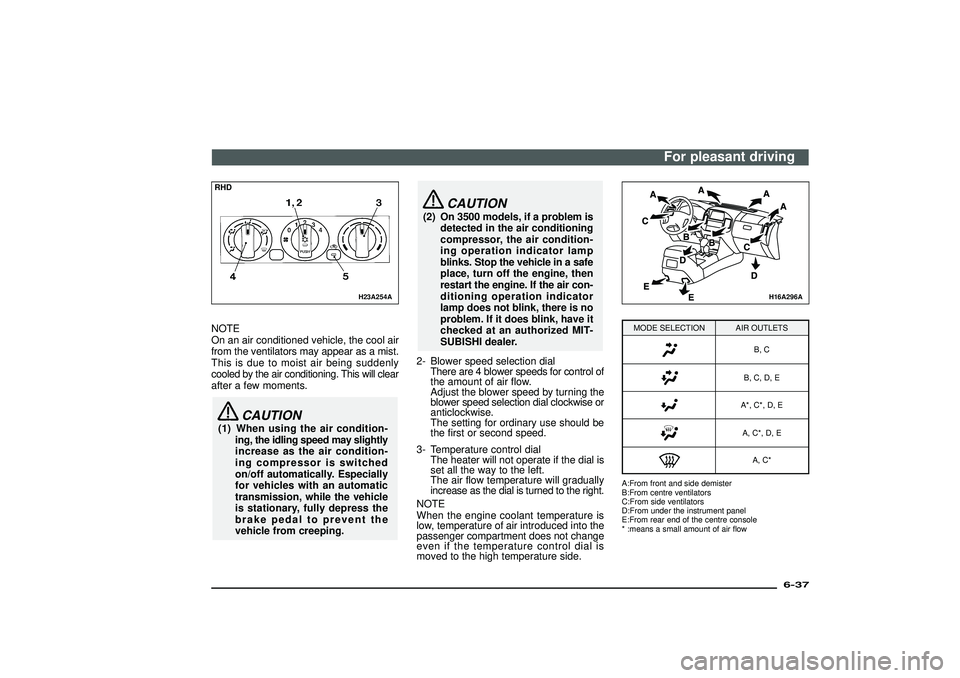
H23A254A
RHDNOTE
On an air conditioned vehicle, the cool air
from the ventilators may appear as a mist.
This is due to moist air being suddenly
cooled by the air conditioning. This will clear
after a few moments.
CAUTION
(1) When using the air condition-
ing, the idling speed may slightly
increase as the air condition-
ing compressor is switched
on/off automatically. Especially
for vehicles with an automatic
transmission, while the vehicle
is stationary, fully depress the
brake pedal to prevent the
vehicle from creeping.
CAUTION
(2) On 3500 models, if a problem is
detected in the air conditioning
compressor, the air condition-
ing operation indicator lamp
blinks. Stop the vehicle in a safe
place, turn off the engine, then
restart the engine. If the air con-
ditioning operation indicator
lamp does not blink, there is no
problem. If it does blink, have it
checked at an authorized MIT-
SUBISHI dealer.
2- Blower speed selection dial
There are 4 blower speeds for control of
the amount of air flow.
Adjust the blower speed by turning the
blower speed selection dial clockwise or
anticlockwise.
The setting for ordinary use should be
the first or second speed.
3- Temperature control dial
The heater will not operate if the dial is
set all the way to the left.
The air flow temperature will gradually
increase as the dial is turned to the right.
NOTE
When the engine coolant temperature is
low, temperature of air introduced into the
passenger compartment does not change
even if the temperature control dial is
moved to the high temperature side.
H16A296A
MODE SELECTION AIR OUTLETS
B, CB, C, D, EA*, C*, D, EA, C*, D, EA, C*
A:From front and side demister
B:From centre ventilators
C:From side ventilators
D:From under the instrument panel
E:From rear end of the centre console
* :means a small amount of air flow
For pleasant driving
6-37
Div:
Out put date:
Page 274 of 392

Changing the temperature
EH18BOI
Select the desired temperature level by
turning clockwise or anticlockwise.
NOTE
The type C or type D rear air conditioning
will not operate unless the front air condi-
tioning compressor is operating. Always
switch the front air conditioning compres-
sor on before using the air conditioning. If
the front air conditioning compressor is not
operating, the system will just operate as
a blower.
H18A139E
Type A, B, DThe temperature will gradually increase as
the dial is turned to the right.
NOTE
When the engine coolant temperature is
low, temperature of air introduced into the
passenger compartment does not change
even if the temperature control dial is
moved to the high temperature side.
For pleasant driving
6-54Div:
Out put date:
Page 320 of 392

WARNING
(1) Remember that under the bon-
net, there can be boiling water
gushing out, or the support bar
could be burning hot. If the bon-
net is opened suddenly, you
could get burnt.
(2) Be careful of hot steam, which
could be blowing off the reserve
tank cap.
(3) Do not attempt to remove the
radiator cap while the engine is
hot.
N26A209A
3. After the engine coolant temperature has
dropped to the normal temperature, stop
the engine.
N26A143A
4. Check the coolant level in the reserve
tank. If there is none, make sure that the
engine has cooled down before remov-
ing the radiator cap, because hot steam
or boiling water otherwise will gush from
the filler port and may scald you.
5. Add coolant to the radiator and/or
reserve tank if necessary (refer to the
“Maintenance”section).
CAUTION
Adding cold water rapidly when the
engine is hot could cause the cylin-
der head and/or block to crack, add
the water a little at a time while run-
ning the engine.
For emergencies
8-22Div:
Out put date:
Page 343 of 392
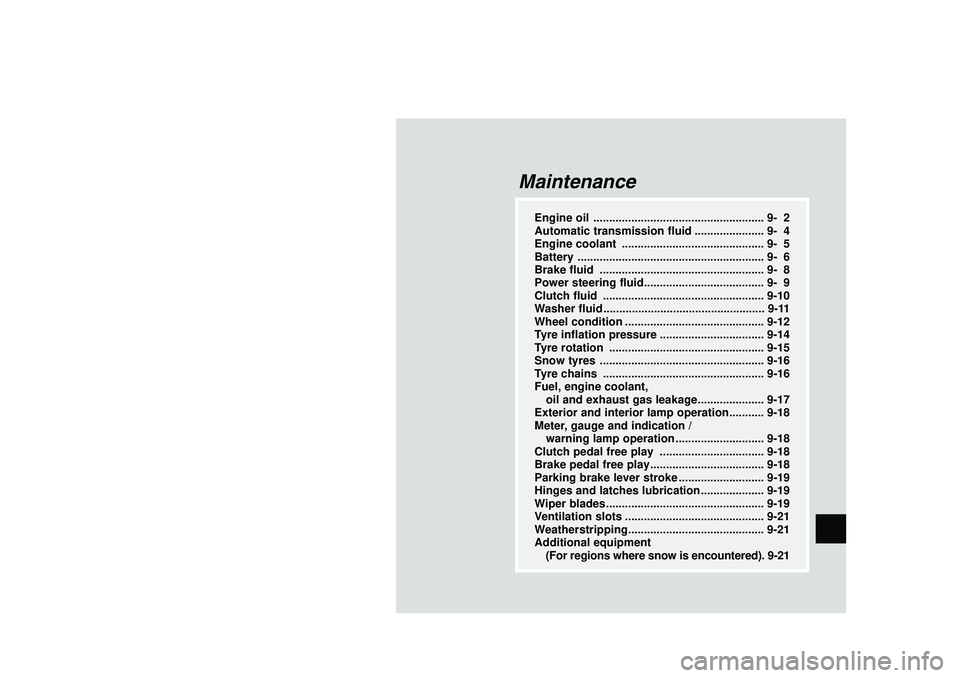
Maintenance
Engine oil ...................................................... 9- 2
Automatic transmission fluid ...................... 9- 4
Engine coolant ............................................. 9- 5
Battery ........................................................... 9- 6
Brake fluid .................................................... 9- 8
Power steering fluid...................................... 9- 9
Clutch fluid ................................................... 9-10
Washer fluid ................................................... 9-11
Wheel condition ............................................ 9-12
Tyre inflation pressure ................................. 9-14
Tyre rotation ................................................. 9-15
Snow tyres .................................................... 9-16
Tyre chains ................................................... 9-16
Fuel, engine coolant,
oil and exhaust gas leakage..................... 9-17
Exterior and interior lamp operation........... 9-18
Meter, gauge and indication /
warning lamp operation ............................ 9-18
Clutch pedal free play ................................. 9-18
Brake pedal free play.................................... 9-18
Parking brake lever stroke ........................... 9-19
Hinges and latches lubrication.................... 9-19
Wiper blades.................................................. 9-19
Ventilation slots ............................................ 9-21
Weatherstripping........................................... 9-21
Additional equipment
(For regions where snow is encountered). 9-21
Div:
Out put date:
Page 347 of 392

N26A143A
Engine coolant
EM36A-Tb
A translucent coolant reserve tank is
located in the engine compartment. The
coolant level in this tank should be kept
between the“LOW”and“FULL”marks
when measured while the engine is cold .
The cooling system is a closed system and
normally the loss of coolant should be very
slight. A noticeable drop in the coolant level
could indicate leakage. If this occurs, have
the system checked at an authorized
MITSUBISHI dealer as soon as possible.
If the level should drop below the“LOW”
level on the reserve tank, open the lid and
add coolant.
Also, if the reserve tank is completely
empty, remove the radiator cap and add
coolant until the level reaches the filler
neck.
WARNING
Do not open the radiator cap while
the engine is hot. The coolant sys-
tem is under pressure and any hot
coolant escaping could cause severe
burns.Anti-freezeThe engine coolant contains an ethylene
glycol anti-corrosion agent. The cylinder
head and water pump housing are cast alu-
minium alloy, and periodic changing of the
engine coolant is necessary to prevent cor-
rosion of these parts.
Use DIA QUEEN SUPER LONG LIFE
COOLANT or equivalent.
MITSUBISHI Genuine Coolant has excel-
lent protection against corrosion and rust
formation of all metals including alu-
minium and can avoid clogs in the radia-
tor, heater, cylinder head, engine block, etc.
Because of the necessity of this
anti-corrosion agent, the coolant must not
be replaced with plain water even in sum-
mer. The required concentration of
anti-freeze differs depending on the
expected ambient temperature.Ambient temperature
(minimum)°C–15–20–25–30–35–50
Anti-freeze
concentration %30 35 40 45 50 60
CAUTION
(1) Do not use alcohol or metha-
nol anti-freeze or any engine
coolants mixed with alcohol or
methanol anti-freeze. The use of
an improper anti-freeze can
cause corrosion of the alu-
minium components.
(2) For effective anti-corrosion and
anti-freeze performance, keep
the anti-freeze concentration
within the range of 30 to 60%.
Concentrations exceeding 60%
will result in a reduction of both
the anti-freeze and cooling per-
formance thus adversely affect-
ing the engine.
(3) Do not top up with water only.
Water by itself reduces the
rust-protective and anti-freeze
qualities of the coolant and has
a lower boiling point. It can also
cause damage to the cooling
system if it should freeze. Do not
use tapwater, as it can cause
corrosion and rust formation.
Maintenance
9-5
Div:
Out put date:
Page 348 of 392
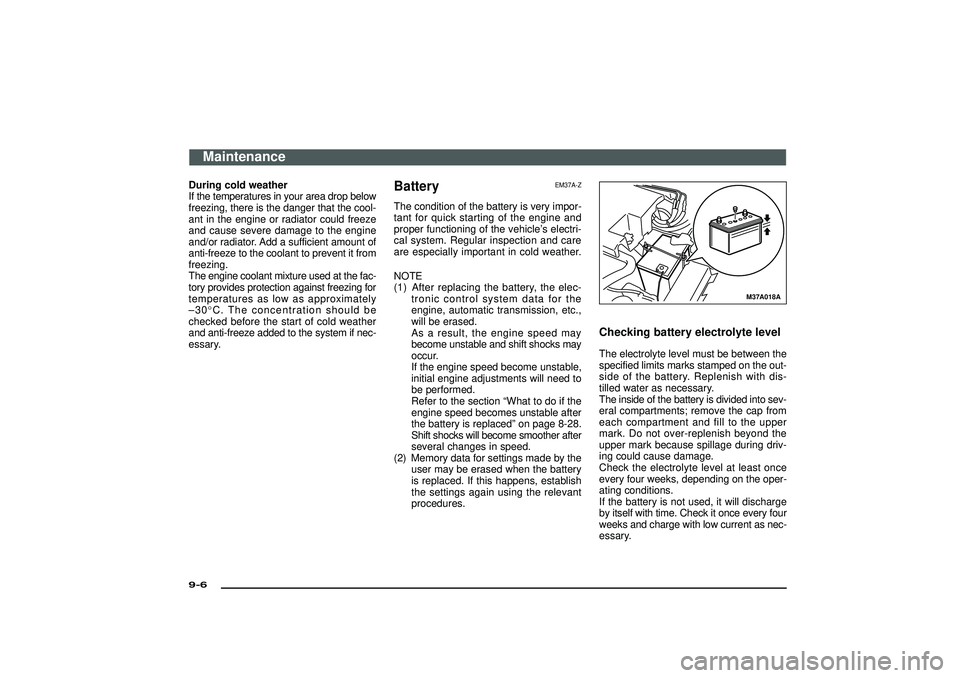
During cold weather
If the temperatures in your area drop below
freezing, there is the danger that the cool-
ant in the engine or radiator could freeze
and cause severe damage to the engine
and/or radiator. Add a sufficient amount of
anti-freeze to the coolant to prevent it from
freezing.
The engine coolant mixture used at the fac-
tory provides protection against freezing for
temperatures as low as approximately
–30°C. The concentration should be
checked before the start of cold weather
and anti-freeze added to the system if nec-
essary.
Battery
EM37A-Z
The condition of the battery is very impor-
tant for quick starting of the engine and
proper functioning of the vehicle’s electri-
cal system. Regular inspection and care
are especially important in cold weather.
NOTE
(1) After replacing the battery, the elec-
tronic control system data for the
engine, automatic transmission, etc.,
will be erased.
As a result, the engine speed may
become unstable and shift shocks may
occur.
If the engine speed become unstable,
initial engine adjustments will need to
be performed.
Refer to the section“What to do if the
engine speed becomes unstable after
the battery is replaced”on page 8-28.
Shift shocks will become smoother after
several changes in speed.
(2) Memory data for settings made by the
user may be erased when the battery
is replaced. If this happens, establish
the settings again using the relevant
procedures.
M37A018A
Checking battery electrolyte levelThe electrolyte level must be between the
specified limits marks stamped on the out-
side of the battery. Replenish with dis-
tilled water as necessary.
The inside of the battery is divided into sev-
eral compartments; remove the cap from
each compartment and fill to the upper
mark. Do not over-replenish beyond the
upper mark because spillage during driv-
ing could cause damage.
Check the electrolyte level at least once
every four weeks, depending on the oper-
ating conditions.
If the battery is not used, it will discharge
by itself with time. Check it once every four
weeks and charge with low current as nec-
essary.
Maintenance
9-6Div:
Out put date:
Page 359 of 392
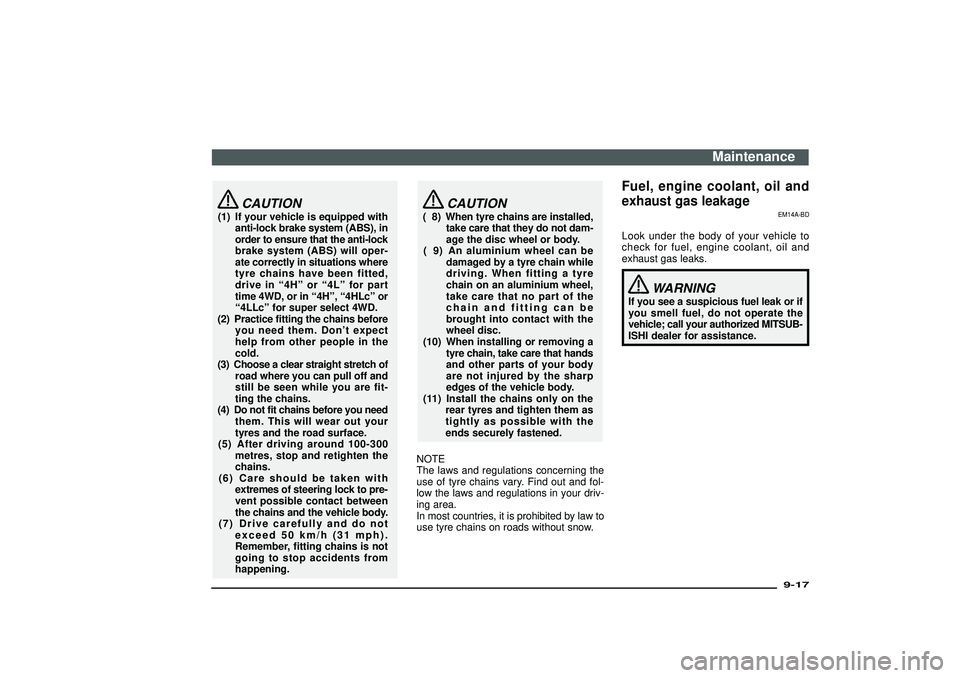
CAUTION
(1) If your vehicle is equipped with
anti-lock brake system (ABS), in
order to ensure that the anti-lock
brake system (ABS) will oper-
ate correctly in situations where
tyre chains have been fitted,
drive in“4H”or“4L”for part
time 4WD, or in“4H”,“4HLc”or
“4LLc”for super select 4WD.
(2) Practice fitting the chains before
you need them. Don’t expect
help from other people in the
cold.
(3) Choose a clear straight stretch of
road where you can pull off and
still be seen while you are fit-
ting the chains.
(4) Do not fit chains before you need
them. This will wear out your
tyres and the road surface.
(5) After driving around 100-300
metres, stop and retighten the
chains.
(6) Care should be taken with
extremes of steering lock to pre-
vent possible contact between
the chains and the vehicle body.
(7) Drive carefully and do not
exceed 50 km/h (31 mph).
Remember, fitting chains is not
going to stop accidents from
happening.
CAUTION
( 8) When tyre chains are installed,
take care that they do not dam-
age the disc wheel or body.
( 9) An aluminium wheel can be
damaged by a tyre chain while
driving. When fitting a tyre
chain on an aluminium wheel,
take care that no part of the
chain and fitting can be
brought into contact with the
wheel disc.
(10) When installing or removing a
tyre chain, take care that hands
and other parts of your body
are not injured by the sharp
edges of the vehicle body.
(11) Install the chains only on the
rear tyres and tighten them as
tightly as possible with the
ends securely fastened.
NOTE
The laws and regulations concerning the
use of tyre chains vary. Find out and fol-
low the laws and regulations in your driv-
ing area.
In most countries, it is prohibited by law to
use tyre chains on roads without snow.
Fuel, engine coolant, oil and
exhaust gas leakage
EM14A-BD
Look under the body of your vehicle to
check for fuel, engine coolant, oil and
exhaust gas leaks.
WARNING
If you see a suspicious fuel leak or if
you smell fuel, do not operate the
vehicle; call your authorized MITSUB-
ISHI dealer for assistance.
Maintenance
9-17
Div:
Out put date: